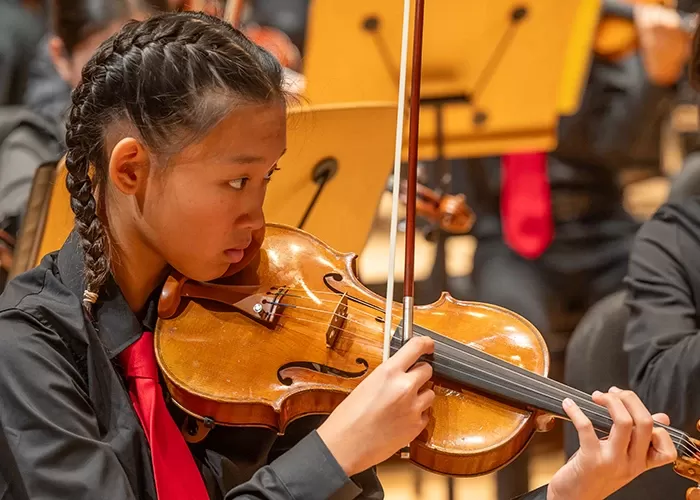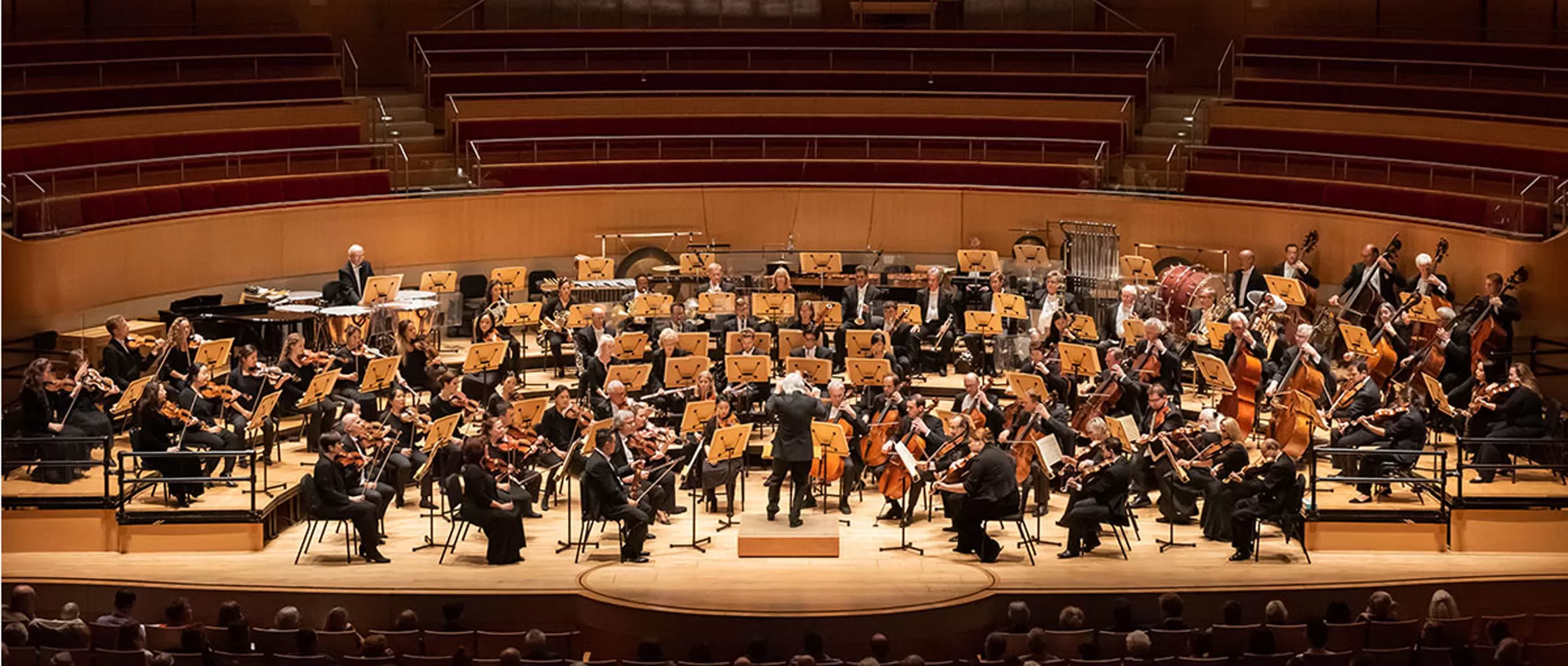Pacific Symphony History
Pacific Symphony, under the dynamic leadership of Music Director Carl St.Clair since 1990, is the resident orchestra of Orange County’s Segerstrom Center for the Arts and performs in the Renée and Henry Segerstrom Concert Hall. Founded in 1978, the Symphony is the largest orchestra formed in the U.S. in the last 50 years and is not only a fixture of musical life in Southern California but is also recognized as an outstanding ensemble making strides on both the national and international scenes.
The Symphony is now entering an exciting new chapter with the announcement of Alexander Shelley as its next Artistic and Music Director. Shelley will assume the role beginning with the 2026-27 season, following St.Clair's remarkable 35-year tenure. Shelley's leadership promises to bring a dynamic vision of inclusivity and creativity, propelling the Symphony into a vibrant future.
In April 2018, Pacific Symphony made its debut at Carnegie Hall as one of two orchestras invited to perform during a yearlong celebration of composer Philip Glass’ 80th birthday, and the following month, the orchestra toured China. The orchestra made its national PBS debut in June 2018 on Great Performances with Peter Boyer’s Ellis Island: The Dream of America, conducted by St.Clair. Presenting more than 100 concerts and events a year and a rich array of education and community engagement programs, the Symphony reaches more than 300,000 residents—from school children to senior citizens.
The Symphony offers repertoire ranging from the great orchestral masterworks to music from today’s most prominent composers. Ten seasons ago, the Symphony launched the highly successful opera initiative, “Symphonic Voices,” which continues in April 2022 with Verdi’s Otello. It also offers a popular Pops season, enhanced by state-of-the-art video and sound. Each Symphony season also includes Café Ludwig, a chamber music series; an educational Family Musical Mornings series; and Sunday Matinées, an orchestral matinée series offering rich explorations of selected works led by St.Clair.
The Symphony offers repertoire ranging from the great orchestral masterworks to music from today’s most prominent composers. More than a decade ago, the Symphony launched the highly successful opera initiative, “Symphonic Voices,” which continues in 2025 with Wagner’s Das Rheingold. It also offers a popular Pops series, enhanced by state-of-the-art video and sound. In 2023, Enrico Lopez-Yañez succeeded Richard Kaufman as Principal Pops Conductor, bringing a fresh and vibrant approach to the series. Each Symphony season also includes Café Ludwig, a chamber music series in a café style ambience with artistic collaboration and direction by pianist Orli Shaham in collaboration with principal musicians of the orchestra; an educational Family Musical Mornings series; Sunday Matinées, an orchestral matinée series offering rich explorations of selected works led by St.Clair; the newly added Candlelight Baroque series; and Symphony on the Go, a mobile stage initiative serving over 20 cities in Orange County each summer.
Founded in 1978 as a collaboration between California State University, Fullerton (CSUF), and North Orange County community leaders led by Marcy Arroues Mulville, the Symphony performed its first concerts at Fullerton’s Plummer Auditorium as the Pacific Chamber Orchestra, under the baton of then-CSUF orchestra conductor Keith Clark. Two seasons later, the Symphony expanded its size and changed its name to Pacific Symphony Orchestra. In 2006, the Symphony moved into the Renée and Henry Segerstrom Concert Hall, with striking architecture by Cesar Pelli and acoustics by Russell Johnson. In 2008, the Symphony inaugurated the hall’s critically acclaimed 4,322-pipe William J. Gillespie Concert Organ. The orchestra embarked on its first European tour in 2006, performing in nine cities across three countries.
Recordings commissioned and performed by the Symphony include William Bolcom’s Songs of Lorca and Prometheus (2015-16), Richard Danielpour’s Toward a Season of Peace and Philip Glass’ The Passion of Ramakrishna (2013-14), Michael Daugherty’s Mount Rushmore and The Gospel According to Sister Aimee (2012-13), and Elliot Goldenthal’s Symphony in G-sharp Minor (2014-15). In 2023, the Symphony released a world-premiere recording of Fiat Lux by Sir James MacMillan and Dana Gioia, a large work for chorus, orchestra, organ, and soloists. The Symphony has also commissioned and recorded Danielpour’s An American Requiem and Goldenthal’s Fire Water Paper: A Vietnam Oratorio featuring Yo-Yo Ma, as well as collaborations with composers Lukas Foss and Toru Takemitsu. Other leading composers commissioned by the Symphony include Paul Chihara, Daniel Catán, James Newton Howard, William Kraft, Ana Lara, Tobias Picker, Christopher Theofanidis, Frank Ticheli, John Wineglass, and Chen Yi. Further demonstrating its commitment to fostering new music, the Symphony appointed Viet Cuong as its Composer-in-Residence in 2022 and will be premiering a new work in 2025.
The Symphony’s education and community engagement programs are among the most innovative in the country, offering a variety of impactful initiatives designed to serve diverse audiences, including:
- arts-X-press: A middle school arts-immersion camp that nurtures creativity and self-expression through hands-on experiences in music, theater, visual arts, and dance.
- Class Act: An elementary school partnership program that integrates music education into the classroom, connecting students with Symphony musicians and fostering a lifelong appreciation for the arts.
- Heartstrings: A community engagement program providing free music lessons, instruments, and mentoring to under-resourced students.
- Music and Wellness Concerts: Performances designed to bring the therapeutic power of music to healthcare and senior living communities.
- Access Concerts: Free tickets to Symphony performances for thousands of individuals and families in underserved communities, ensuring everyone has the opportunity to experience live music.
- Savanna Strings: A targeted initiative providing string instrument instruction to students in underrepresented schools.
- Building Communities Concerts: Celebrations that highlight cultural traditions, such as the Lunar New Year, Nowruz, and the newly announced Symphony Soul concert debuting in 2025.
- Lantern Festival: An annual community event celebrating the Lunar New Year with music, dance, and cultural activities.
The Symphony also supports the development of young musicians through its Youth Ensembles, which include Pacific Symphony Youth Orchestra, Pacific Symphony Youth Wind Ensemble, Pacific Symphony Santiago Strings and Pacific Symphony Youth Concert Band. These ensembles have toured internationally and won prestigious competitions.
In both 2005 and 2010, the Symphony received the prestigious ASCAP Award for Adventurous Programming. In 2010, a League of American Orchestras study, Fearless Journeys, included the Symphony as one of the country’s five most innovative orchestras. With its broad repertoire, innovative programming, and deep community connections, Pacific Symphony remains a vibrant and essential part of the cultural fabric of Southern California.


